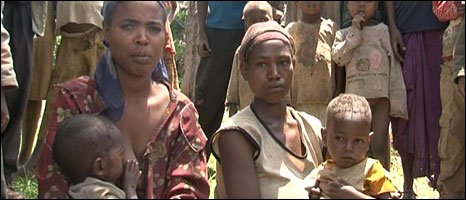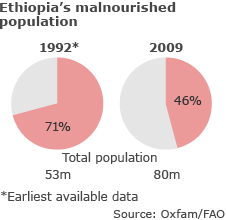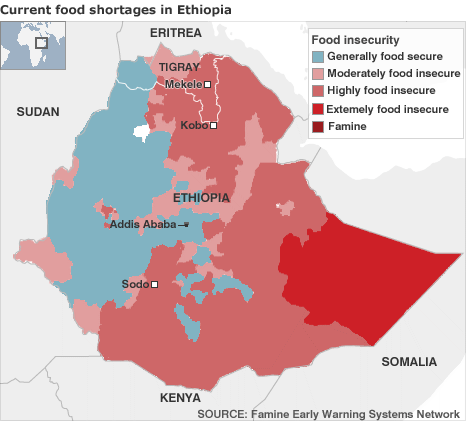From: Berhane Habtemariam (Berhane.Habtemariam@gmx.de)
Date: Thu Oct 22 2009 - 11:22:16 EDT
Hunger stalks Ethiopia once again
Yangago Bunja tells how drought has brought fresh fear to his town
By Mike Wooldridge
BBC world affairs correspondent, Ethiopia
Thursday, 22 October 2009 09:34 UK
http://newsimg.bbc.co.uk/shared/img/999999.gif
Dying crops are giving greater urgency to Ethiopia's battle to make its
people less vulnerable to hunger - 25 years after the 1984 famine that
killed an estimated one million people.
But the current food crisis - that Ethiopia shares with other countries in
the region - also risks diverting attention and resources from protecting
farming families against potential disaster.
http://newsimg.bbc.co.uk/shared/img/o.gif
http://newsimg.bbc.co.uk/nol/shared/img/v3/start_quote_rb.gifIt is God who
has been feeding us all this time
http://newsimg.bbc.co.uk/nol/shared/img/v3/end_quote_rb.gif
Yangago Bunja
In two of the 12 districts of this part of southern Ethiopia, the
authorities say there has been a complete failure of the latest maize crop.
They say other districts are relatively better off at the moment - but
Wolayta has a population of about 1.6 million so any shortfall in food
production can have a serious impact.
In Duguna Fango, one of the worst-hit districts not far from the local
capital Sodo, farmer Yangago Bunja explained what the loss of his burnt and
withered maize meant for his family.
Forty years old, he has eight children ranging in age from four months to 18
years old.
"We have nothing. We have a really big problem," he said.
The last three years had been the same, he said.
Mr Yangago said he had tried to fend for his family by working in other
places as a daily labourer.
But his children were losing weight and two of them were sick. He said
sickness among the children was a problem for their whole community.
The only other way he could get food was to borrow from somebody - but
lenders want interest.
"It is God who has been feeding us all this time. We are just praying," he
said.
On the way to Wolayta there are a good many other fields where the maize
crop has been lost to a lengthy drought and erratic, inadequate rain -
sometimes, oddly, right alongside a plot where the maize looks much
healthier.
The failure of crops and the loss of pasture for livestock is sufficiently
widespread in Ethiopia for an expected announcement by the government to
call for emergency food aid to feed 6.2 million people.
Pie charts of Ethiopia hunger
Some aid officials believe that could prove to be a conservative figure.
And it is on top of the food aid to support more than seven million people
under a scheme for those who are most chronically vulnerable to hunger
during lean periods of the year.
It also comes as the UN's food agency has warned that - across the world -
there are more hungry people and there is less food aid than ever before.
Ethiopian officials accept that the devastating famine of the mid-1980s is
part of the country's history but they are anxious that the abiding images
of starvation from that time should not be a prism through which the
country's prospects are viewed today.
Government spokesman Bereket Simon talks of the efforts being made to
improve agricultural productivity, to conserve water and soil and generally
to help farmers become more capable of resisting the more frequent droughts
that are part of the impact of climate change.
Enabling more farmers to have the benefits of irrigation would, of course,
be part of that, too.
Iconic image
In his hard-hit part of rural Wolayta, Mr Yangago says some farmers in the
area now have pumps to irrigate their land but he cannot afford to do so.
And given that his main crop has now failed again, it seems even less likely
to happen in the near future.
It is not just the strategies for supporting farmers with failing crops that
will be tested in the coming weeks. So will the new approach to trying to
save the lives of children who become severely malnourished.
The feeding centres of the past were an iconic image of the 1984 famine.
They have given way to mothers collecting Plumpy'nut - a mix of peanut
butter, sugar and nutrients - from their local health post and feeding it to
malnourished children at home.
The most vulnerable children are supposed to be sent to stabilisation
centres.
Abebech Adabbo's 12-month-old son is being treated this way. The child has
scarring on his head that a health worker said was the result of
malnutrition.
And Abebech Tafesse hold her four-year old boy in her arms. He still has
thin legs but she fells he is improving.
The mothers said it was shortage of food that had weakened the two children
- two among many on the front line as Ethiopia faces the challenge once
again of preventing a crisis becoming something worse.
Ethiopia mapAbebech Adabbo (left) and Abebech Tafesse (right)
Abebech Adabbo and Abebech Tafesse say their children are suffering





----[This List to be used for Eritrea Related News Only]----